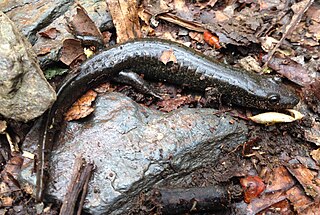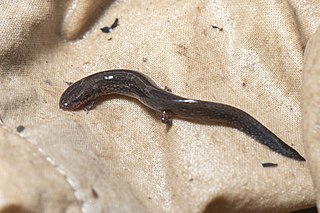
The long-nosed horned frog, also known as the Malayan horned frog or Malayan leaf frog is a species of frog restricted to the rainforest areas of southern Thailand and Peninsular Malaysia to Singapore, Sumatra, and Borneo. However, records from Thailand to the Sunda Shelf may apply to another, possibly unnamed species.

Holbrook's southern dusky salamander, previously known as the southern dusky salamander, is a species of salamander endemic to the southeastern United States. Older sources often refer to it as the eared triton. Formerly abundant, it has precipitously declined since the 1960s.

The speckledblack salamander, previously known as just the black salamander, is a species of salamander in the family Plethodontidae. It is endemic to the U.S. state of California. Its natural habitats are temperate forests and temperate grassland. It is threatened by habitat loss.

The seepage salamander is a small, terrestrial species of salamander in the family Plethodontidae. It is endemic to the United States. They are found in small areas of Tennessee, North Carolina, Georgia, and Alabama. Its natural habitats are temperate forests, intermittent rivers, and freshwater springs. It gets its name from the seepages around which it lives. It is very similar in its appearance and life history to the pygmy salamander. These two species differ greatly from the other Desmognathus species. They are the smallest salamanders in the genus, measuring only 3–5 cm (1–2 in) in length. They are also the only two terrestrial, direct-developing Desmognathus species. However, the two species are not often seen to coexist, differing in distribution by elevation; although there are exceptions. The seepage salamander is currently listed as Near Threatened, with its numbers declining in most of states in which it is found. It is threatened by habitat loss, with logging having a major effect.

Desmognathus fuscus is a species of amphibian in the family Plethodontidae. The species is commonly called the dusky salamander or northern dusky salamander to distinguish it from populations in the southern United States which form several distinct species, the southern dusky salamanders. The northern dusky salamander is the most widespread representative of its genus in Canada. It can be found in eastern North America from extreme eastern Canada in New Brunswick south to South Carolina. The size of the species' total population is unknown, but is assumed to easily exceed 100,000. The species' habitat differs somewhat geographically; dusky salamanders in the northern part of the range prefer rocky woodland streams, seepages, and springs, while those in the south favor floodplains, sloughs, and muddy places along upland streams. They are most common where water is running or trickling. They hide under various objects, such as leaves or rocks, either in or near water. Alternatively, they may enter burrows for protection. The dusky salamander lays its eggs close to water under moss or rocks, in logs, or in stream-bank cavities. The larval stage which follows is normally aquatic.

The imitator salamander is a species of salamander in the family Plethodontidae. It is endemic to the Appalachian Mountains in the southeastern United States.

The seal salamander is a species of lungless salamander that is endemic to the Eastern United States.

The blackbelly salamander is a species of salamander in the family Plethodontidae. It is endemic to the United States. Its natural habitats are rivers, intermittent rivers, and freshwater springs. It is threatened by habitat loss.
The black mountain salamander is a species of salamander in the family Plethodontidae.

The red-cheeked salamander, also known as the Jordan's salamander, Jordan's redcheek salamander, or Appalachian woodland salamander, is a species of salamander in the family Plethodontidae. It is endemic to the Appalachian Mountains in the southeastern United States.

The many-lined salamander is a species of salamander in the family Plethodontidae. It is the only species of the monotypic genus Stereochilus. It is endemic to the United States.

The coastal giant salamander is a species of salamander in the family Dicamptodontidae. It is endemic to the Pacific Northwest of North America. There are three closely related species to this taxon: D. ensatus, D. copei, and D. aterrimus.

Valentine's southern dusky salamander is a species of salamander in the family Plethodontidae. It is endemic to the southeastern United States.

The golden shovel-nosed salamander is a species of salamander in the family Plethodontidae. It is endemic to the United States.
The black shovel-nosed salamander is a species of salamander in the family Plethodontidae. It is endemic to the United States.

The Cherokee black-bellied salamander or Smoky Mountains black-bellied salamander is a species of lungless salamander in the family Plethodontidae. It is endemic to the eastern United States, where it is only known from the southern Appalachian Mountains.
The Kanawha black-bellied salamander or New River black-bellied salamander is a species of lungless salamander in the family Plethodontidae. It is endemic to the eastern United States, where it is only known from the south-central Appalachian Mountains.

The Pisgah black-bellied salamander or Blue Ridge black-bellied salamander is a species of lungless salamander in the family Plethodontidae. It is endemic to the eastern United States, where it is only known from the southern Appalachian Mountains.















